Abstract
The number of colonies formed by unirradiated Clostridium botulinum 62A spores was independent of temperature, in the range from 20 to 45 degrees C (in 5 degrees C increments); no colonies developed at 50 degrees C. Spores irradiated at 1.2 or 1.4 Mrads produced more macrocolonies at 40 degrees C than at higher or lower temperatures. Apparently, radiation-injured spores were capable of repair of 40 degrees C than at the other temperatures studied. More than 99% of the radiation (1.2 Mrads) survivors were injured and were unable to form macrocolonies in the presence of 5% NaCl. The germinated radiation-injured spores were also sensitive to dilution, resulting in the loss of viability of 77 to 79% of the radiation survivors. At 30 and 40 degrees C, the irradiated spores did not differ significantly in the extent of germination (greater than 99% at both 30 and 40 degrees C), emergence (64% at 30 degrees C and 67% at 40 degrees C), and the maximum number of emerged cells that started to elongate (69% at 30 degrees C and 79% at 40 degrees C). However, elongation was remarkably more extensive at 40 degrees C than at 30 degrees C. Many elongated cells lysed within 48 h at 30 degrees C, indicating an impaired repair mechanism. If the radiation-injured spores were incubated at 40 degrees C in the recovery (repair) medium for 8 to 10 h, they germinated, emerged, and elongated extensively and were capable of repair. If, after 8 to 10 h at 40 degrees C, these cultures were shifted to 30 degrees C, the recovery at 30 increased by more than eightfold, resulting in similar colony counts at 30 and 40 degrees C. Thus, repair appeared to be associated with outgrowth. Repair did not occur in the presence of chloramphenicol at 40 degrees C, whereas penicillin had no effect, suggesting that the repair involved protein synthesis but did not require multiplication.
Full text
PDF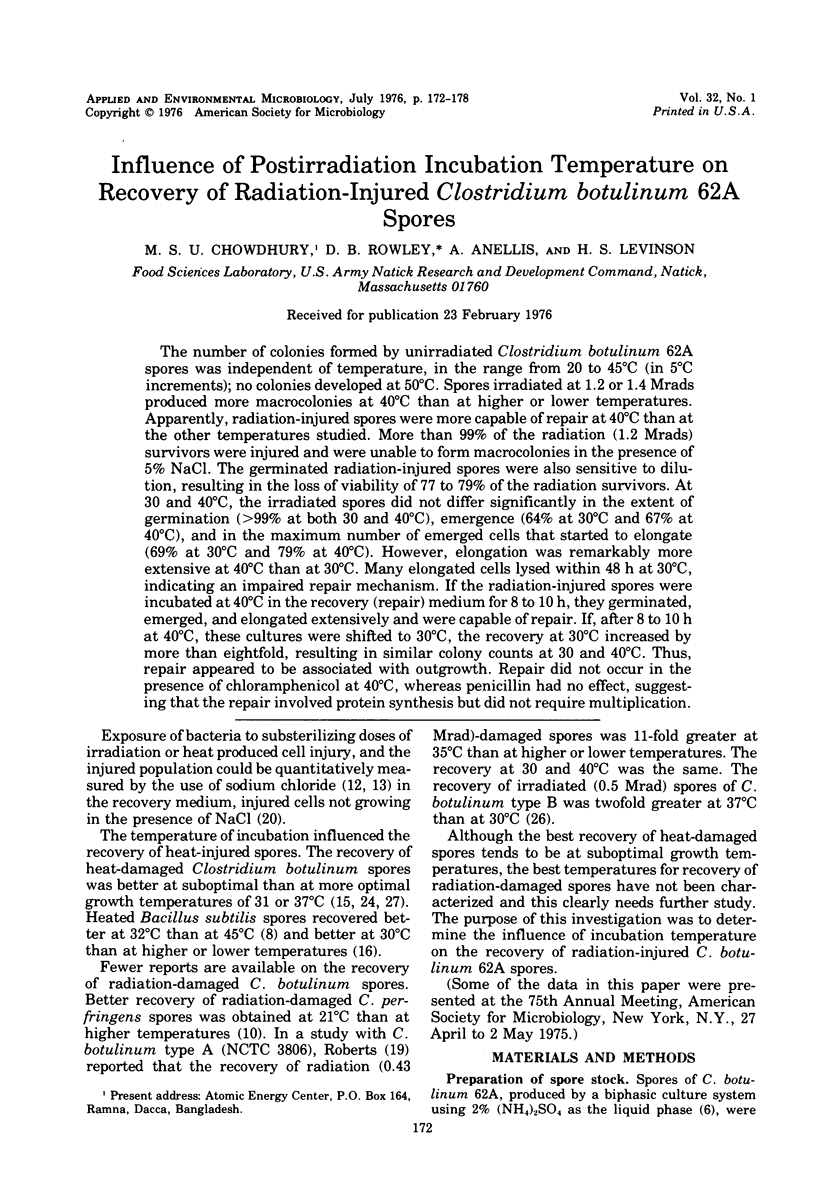
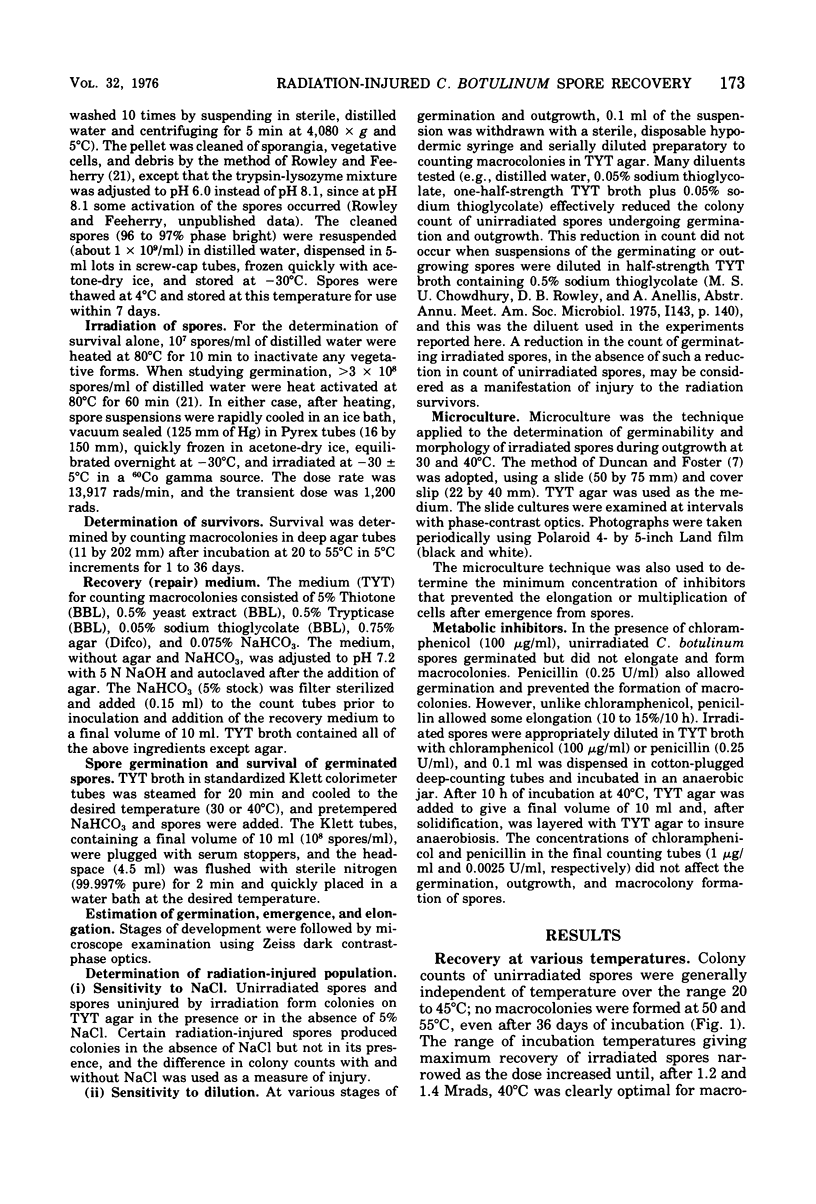
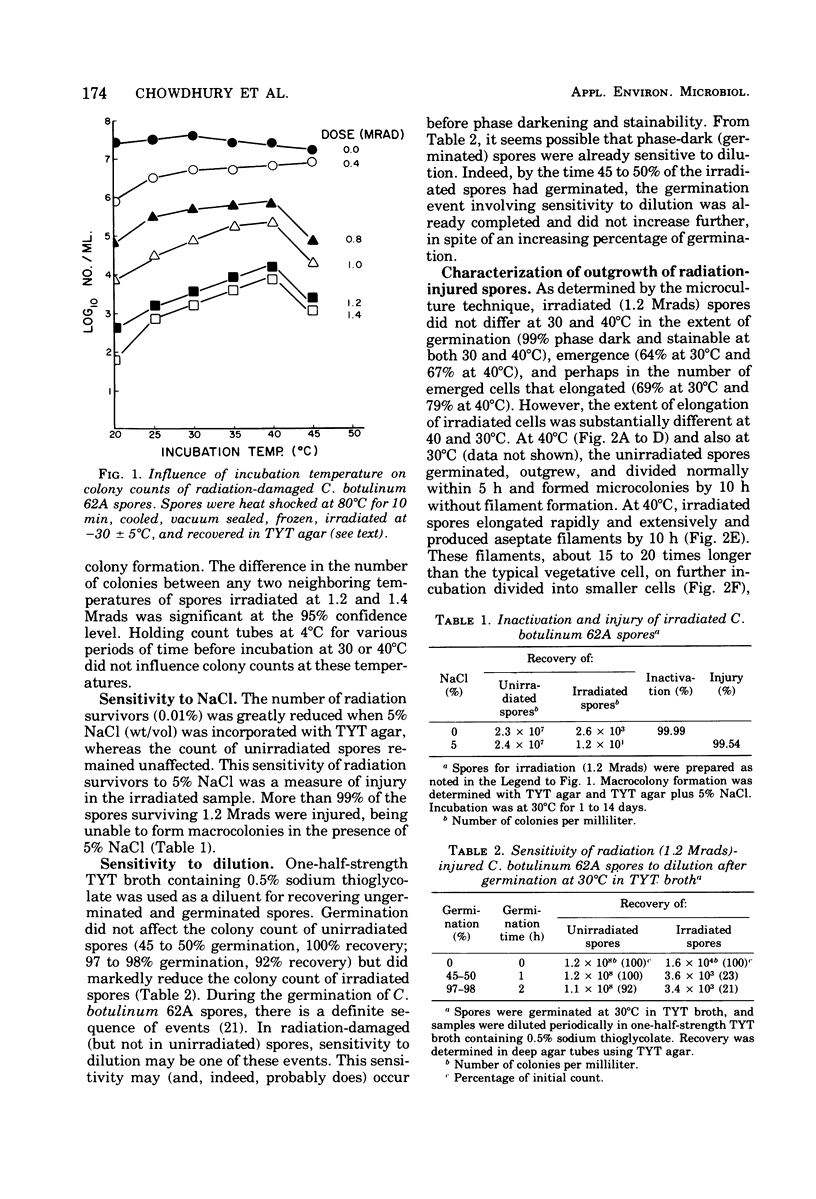
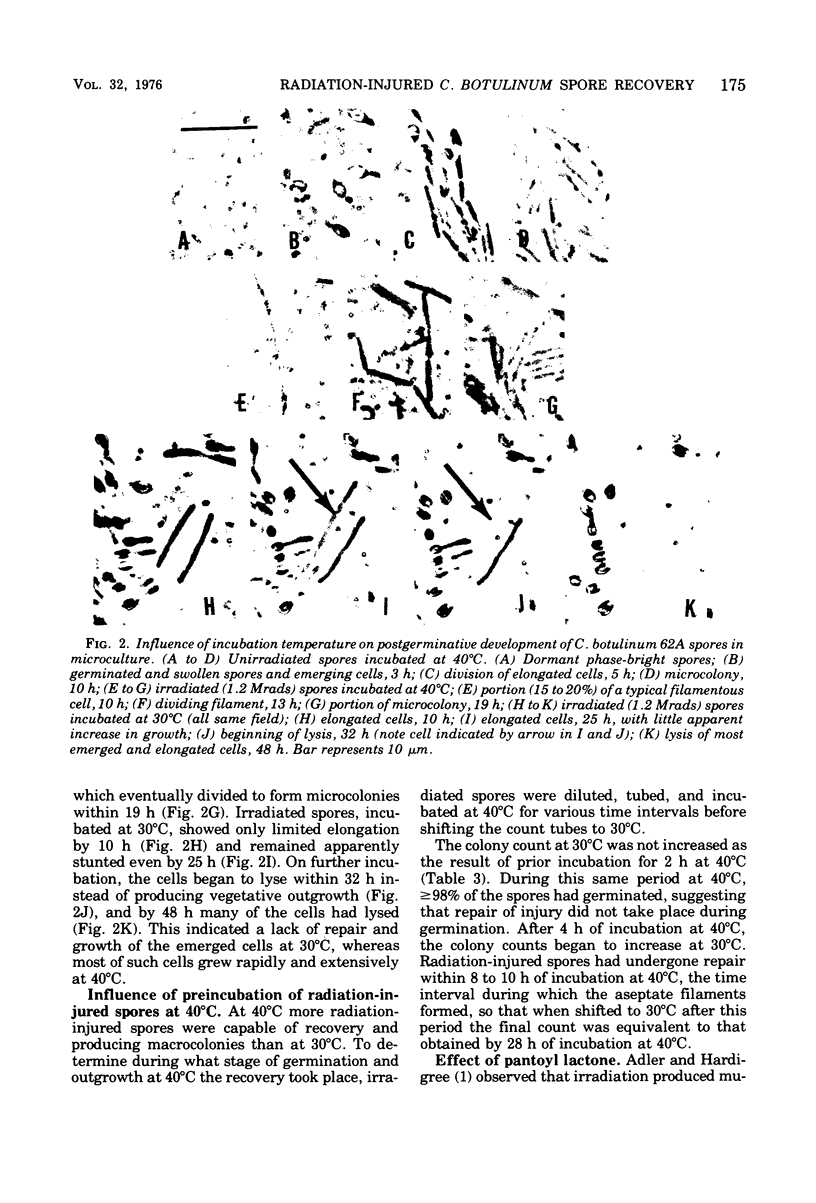
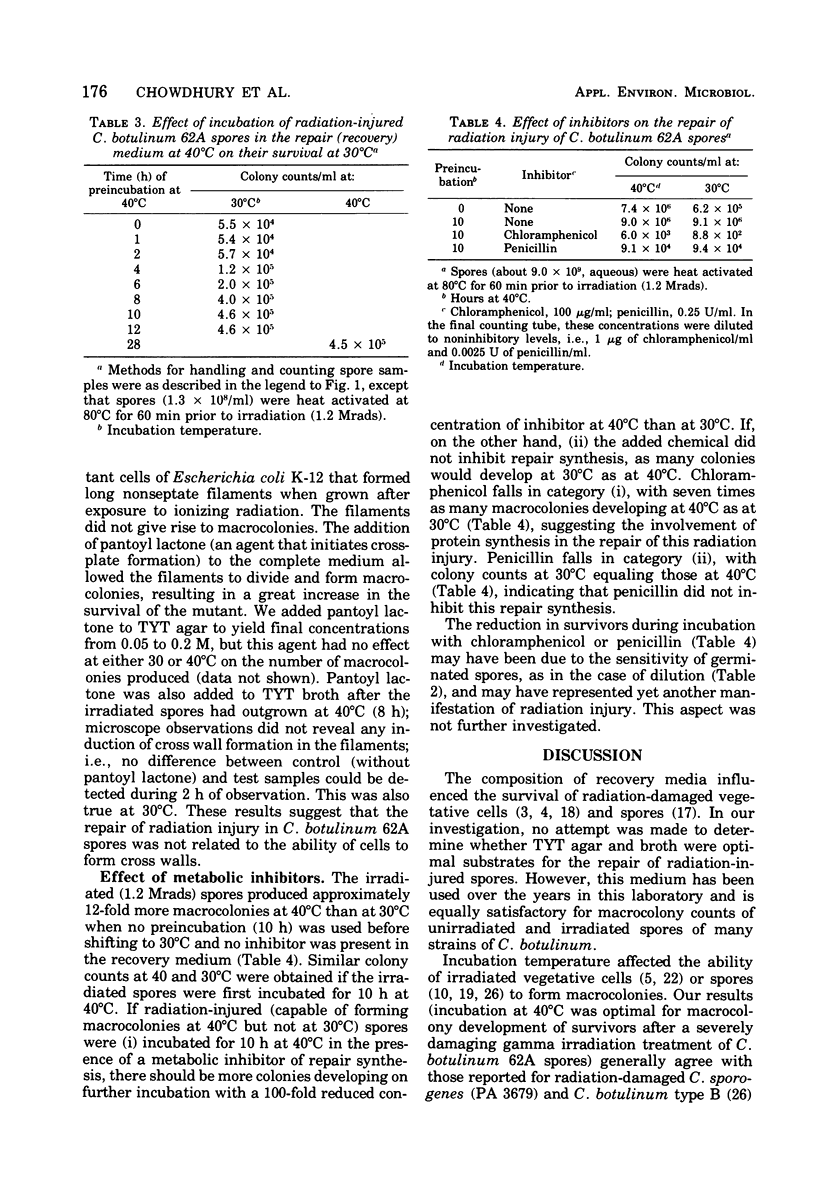
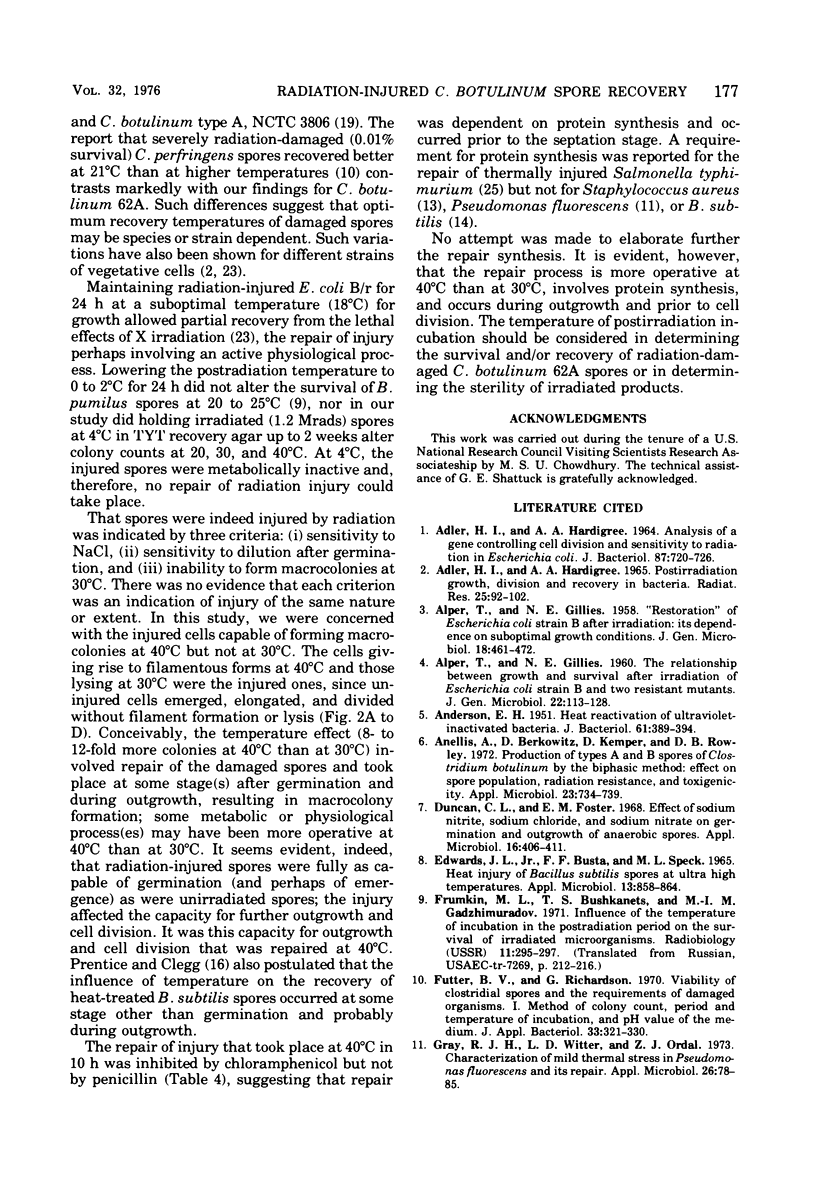
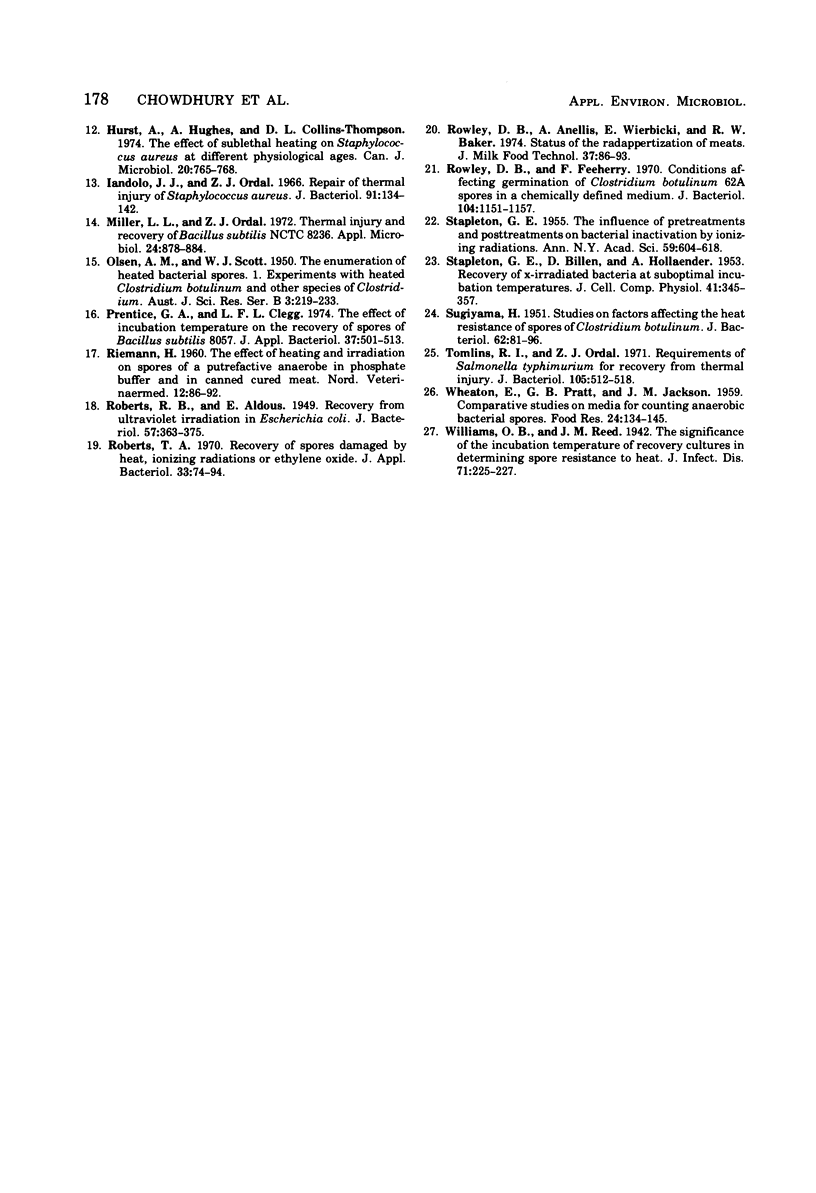
Images in this article
Selected References
These references are in PubMed. This may not be the complete list of references from this article.
- ADLER H. I., HARDIGREE A. A. ANALYSIS OF A GENE CONTROLLING CELL DIVISION AND SENSITIVITY TO RADIATION IN ESCHERICHIA COLI. J Bacteriol. 1964 Mar;87:720–726. doi: 10.1128/jb.87.3.720-726.1964. [DOI] [PMC free article] [PubMed] [Google Scholar]
- ADLER H. I., HARDIGREE A. A. POSTIRRADIATION GROWTH, DIVISION, AND RECOVERY IN BACTERIA. Radiat Res. 1965 May;25:92–102. [PubMed] [Google Scholar]
- ALPER T., GILLIES N. E. Restoration of Escherichia coli strain B after irradiation: its dependence on suboptimal growth conditions. J Gen Microbiol. 1958 Apr;18(2):461–472. doi: 10.1099/00221287-18-2-461. [DOI] [PubMed] [Google Scholar]
- ALPER T., GILLIES N. E. The relationship between growth and survival after irradiation of Escherichia coli strain B and two resistant mutants. J Gen Microbiol. 1960 Feb;22:113–128. doi: 10.1099/00221287-22-1-113. [DOI] [PubMed] [Google Scholar]
- ANDERSON E. H. Heat reactivation of ultraviolet-inactivated bacteria. J Bacteriol. 1951 Apr;61(4):389–394. doi: 10.1128/jb.61.4.389-394.1951. [DOI] [PMC free article] [PubMed] [Google Scholar]
- Anellis A., Berkowitz D., Kemper D., Rowley D. B. Production of types A and B spores of Clostridium botulinum by the biphasic method: effect on spore population, radiation resistance, and toxigenicity. Appl Microbiol. 1972 Apr;23(4):734–739. doi: 10.1128/am.23.4.734-739.1972. [DOI] [PMC free article] [PubMed] [Google Scholar]
- Duncan C. L., Foster E. M. Effect of sodium nitrite, sodium chloride , and sodium nitrate on germination and outgrowth of anaerobic spores. Appl Microbiol. 1968 Feb;16(2):406–411. doi: 10.1128/am.16.2.406-411.1968. [DOI] [PMC free article] [PubMed] [Google Scholar]
- Edwards J. L., Jr, Busta F. F., Speck M. L. Heat injury of Bacillus subtilis spores at ultrahigh temperatures. Appl Microbiol. 1965 Nov;13(6):858–864. doi: 10.1128/am.13.6.858-864.1965. [DOI] [PMC free article] [PubMed] [Google Scholar]
- Frumkin M. L., Bushkanets T. S., Gadzhimuradov M. M. Vliianie temperatury inkubatsii v postradiatsionnyi period na vyzhivaemost' obluchennykh mikroorganizmov. Radiobiologiia. 1971 Mar-Apr;11(2):295–297. [PubMed] [Google Scholar]
- Futter B. V., Richardson G. Viability of clostridial spores and the requirements of damaged organisms. I. Method of colony count, period and temperature of incubation, and pH value of the medium. J Appl Bacteriol. 1970 Jun;33(2):321–330. doi: 10.1111/j.1365-2672.1970.tb02203.x. [DOI] [PubMed] [Google Scholar]
- Gray R. J., Witter L. D., Ordal Z. J. Characterization of mild thermal stress in Pseudomonas fluorescens and its repair. Appl Microbiol. 1973 Jul;26(1):78–85. doi: 10.1128/am.26.1.78-85.1973. [DOI] [PMC free article] [PubMed] [Google Scholar]
- Hurst A., Hughes A., Collins-Thompson D. L. The effect of sublethal heating on Staphylococcus aureus at different physiological ages. Can J Microbiol. 1974 May;20(5):765–768. doi: 10.1139/m74-117. [DOI] [PubMed] [Google Scholar]
- Iandolo J. J., Ordal Z. J. Repair of thermal injury of Staphylococcus aureus. J Bacteriol. 1966 Jan;91(1):134–142. doi: 10.1128/jb.91.1.134-142.1966. [DOI] [PMC free article] [PubMed] [Google Scholar]
- Miller L. L., Ordal Z. J. Thermal injury and recovery of Bacillus subtilis. Appl Microbiol. 1972 Dec;24(6):878–884. doi: 10.1128/am.24.6.878-884.1972. [DOI] [PMC free article] [PubMed] [Google Scholar]
- Prentice G. A., Clegg L. F. The effect of incubation temperature on the recovery of spores of Bacillus subtilis 8057. J Appl Bacteriol. 1974 Dec;37(4):501–513. doi: 10.1111/j.1365-2672.1974.tb00475.x. [DOI] [PubMed] [Google Scholar]
- Roberts R. B., Aldous E. RECOVERY FROM ULTRAVIOLET IRRADIATION IN ESCHERICHIA COLI. J Bacteriol. 1949 Mar;57(3):363–375. doi: 10.1128/jb.57.3.363-375.1949. [DOI] [PMC free article] [PubMed] [Google Scholar]
- Roberts T. A. Symposium on bacterial spores: VII. Recovering spores damaged by heat, ionizing radiations or ethylene oxide. J Appl Bacteriol. 1970 Mar;33(1):74–94. doi: 10.1111/j.1365-2672.1970.tb05235.x. [DOI] [PubMed] [Google Scholar]
- Rowley D. B., Feeherry F. Conditions Affecting Germination of Clostridium botulinum 62A Spores in a Chemically Defined Medium. J Bacteriol. 1970 Dec;104(3):1151–1157. doi: 10.1128/jb.104.3.1151-1157.1970. [DOI] [PMC free article] [PubMed] [Google Scholar]
- STAPLETON G. E., BILLEN D., HOLLAENDER A. Recovery of x-irradiated bacteria at suboptimal incubation temperatures. J Cell Physiol. 1953 Apr;41(2):345–357. doi: 10.1002/jcp.1030410211. [DOI] [PubMed] [Google Scholar]
- STAPLETON G. E. The influence of pretreatments and posttreatments on bacterial inactivation by ionizing radiations. Ann N Y Acad Sci. 1955 Feb 3;59(4):604–618. doi: 10.1111/j.1749-6632.1955.tb45973.x. [DOI] [PubMed] [Google Scholar]
- SUGIYAMA H. Studies on factors affecting the heat resistance of spores of Clostridium botulinum. J Bacteriol. 1951 Jul;62(1):81–96. doi: 10.1128/jb.62.1.81-96.1951. [DOI] [PMC free article] [PubMed] [Google Scholar]
- Tomlins R. I., Ordal Z. J. Requirements of Salmonella typhimurium for recovery from thermal injury. J Bacteriol. 1971 Feb;105(2):512–518. doi: 10.1128/jb.105.2.512-518.1971. [DOI] [PMC free article] [PubMed] [Google Scholar]



